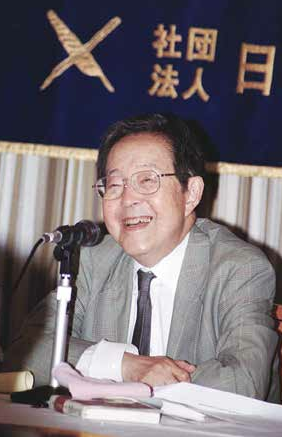Issue:
The formal obituaries of Shijuro Ogata, the former deputy governor of the Bank of Japan who died in April at the age of 86, took due note of his policy-making roles over a long career, invariably executed with acumen. They also recorded that, as he frequently said with affection, he was hardly the most famous Ogata in his own household, second to his wife, Sadako, who was the UN High Commissioner for Refugees for a decade and holder of more than one Japanese government humanitarian portfolio.
What is less well known is the extent to which he was single-handedly responsible for opening up the previously closed Japanese bureaucracy to the western media and all through the device of a tea party of his own mischievous creation.
In the early 1980s the BoJ was gen-erally considered to be subservient to, even under the thumb of, the mighty Ministry of Finance. Additionally, at the time, all Japanese government departments, with the exception of, naturally enough, the Foreign Minis-try, which had no alternative, did not recognize the existence of foreign correspondents based in Tokyo. They preferred to deal with the strictly Japanese kisha (press) clubs, from which foreigners were excluded.
The same was true of Japanese industry. The prime example of this was when Toyota, announcing its first-ever foreign manufacturing facility in California, forgot to apprise the American media, which learned about it the next day from Japanese newspapers. Representations were made, from the Foreign Correspondents’ Club on down, and Toyota promised never to do such a thing again.
All this never seemed right to Mr. Ogata, who combined the best of Japan’s often-suppressed liberal tradition with a puckish sense of humor and who, it so happened, spoke English perfectly. So, perhaps initially more in hope than in expectation, he began a series of weekly Thursday afternoon tea parties for resident foreign correspondents at which he would expand on the BoJ’s thinking on monetary and economic policy.

He never made great news but he did make good copy, and what the BoJ thought began to appear in the Western press, like the FT, the Wall Street Journal and other influential foreign publications. This was anathema to MoF, unaccustomed as it was for the central bank to have a voice at all about anything.
MoF felt it had to respond and get its views out, too, and it had the man to match Ogata in the person of Toyoo Gyohten, its articulate and aggressive senior bureaucrat, then serving as deputy minister and equally fluent in English (but also known as “the beast”). So it began Friday night wine and cheese parties for the foreign hacks, who were suspected to be more partial to liquor than tea.
Eventually this came to the attention of MITI, the Ministry of International Trade and Industry, which then truly ruled the economic roost as the acknowledged mastermind of the Japanese econom-ic miracle, recognized by no less than Chalmers Johnson, the formidable University of California Japan specialist. MITI made available its policy makers to foreign journalists at dinners as lavish as only the Japanese can provide, sometimes one-on-one, occasionally en masse. The foreign press reeled, in more ways than one.
Mr. Ogata, mission accomplished, reveled in all this. It was evidence, in his view, that Japan could become the more open society he desired. This was after all in his bloodline, being from a distinguished family steeped in exposure to the wider world.
In the 1860s, before the formal Meiji Restoration, his grandfather had been dispatched by the Emperor to Manchester, England, to learn more about this industrial revolution that had barely touched Japan. He reported back on the city’s belching smokestacks and concluded, much as Lincoln Steffens did about Lenin’s Soviet Union 60 years later, that he had “seen the future and it works.”
Mr. Ogata himself was the son of the editor of the Asahi Shimbun, a bastion of Japanese liberalism before he, and the newspaper he ran, were eventually co-opted into the Japanese war effort in the 1940s. He was still a teenager when nuclear bombs destroyed Hiroshima and Nagasaki, and remembered thinking at the time that the war was all over for his country. He was an old man when he had a letter published in the FT two years ago bemoaning that Japanese nationalists were provoking an unnecessary dispute with China over the Senkaku Islands. He stayed true to his beliefs throughout his life.
On a personal note, he and Sadako were my best eyes and ears (and friends) on the mystery that was Japan when I lived and reported from there, never more so than on the most difficult story I ever had to write, on the 40th anniversary of Hiroshima. Nobody ever gave me a better insight on what it meant to the Japanese.
Still, the indelible memory is of those early tea parties, down to the biscuits and the china cups. The sadness at his death is made the more acute by the knowledge that, in some ways, Japan has reverted to pre-Ogata type.
Jurek Martin was Tokyo bureau chief of the Financial Times from 1982-1986, and was FCCJ President from 1985-1986. This article first appeared in the Financial Times World blog.

